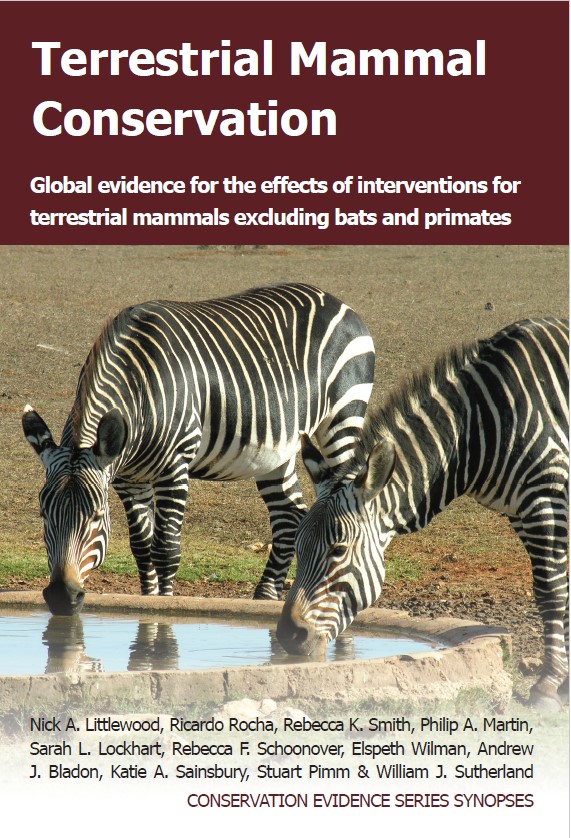Actions to conserve biodiversity
We have summarised evidence from the scientific literature about the effects of actions to conserve wildlife and ecosystems.
Review the evidence from the studies
Not sure what Actions are? Read a brief description.
Search for evidence
e.g. "frogs chytrid"
294 Actions found
Refine
Hide
294 Actions found
Download Actions
| 0 selected |
|
Order results by:
| Action | Effectiveness | Studies | Category | |
|---|---|---|---|---|
|
Use taste-aversion to reduce predation of livestock by mammals to deter human-wildlife conflict Action Link |
Likely to be beneficial | 9 |
|
|
|
Translocate mammals to reduce overpopulation Action Link |
Trade-off between benefit and harms | 3 |
|
|
|
Translocate predators for ecosystem restoration Action Link |
Likely to be beneficial | 2 |
|
|
|
Dispose of livestock carcasses to deter predation of livestock by mammals to reduce human-wildlife conflict Action Link |
Unknown effectiveness (limited evidence) | 1 |
|
|
|
Use guardian animals (e.g. dogs, llamas, donkeys) bonded to livestock to deter predators to reduce human-wildlife conflict Action Link |
Beneficial | 12 |
|
|
|
Use holding pens at release site prior to release of translocated mammals Action Link |
Likely to be beneficial | 35 |
|
|
|
Use loud noises to deter predation of livestock by mammals to reduce human-wildlife conflict Action Link |
Likely to be beneficial | 3 |
|
|
|
Translocate predators away from livestock to reduce human-wildlife conflict Action Link |
Trade-off between benefit and harms | 11 |
|
|
|
Provide diversionary feeding to reduce predation of livestock by mammals to reduce human-wildlife conflict Action Link |
Unknown effectiveness (limited evidence) | 2 |
|
|
|
Keep livestock in enclosures to reduce predation by mammals to reduce human-wildlife conflict Action Link |
Likely to be beneficial | 1 |
|
|
|
Install electric fencing to protect crops from mammals to reduce human-wildlife conflict Action Link |
Beneficial | 11 |
|
|
|
Install metal grids at field entrances to prevent mammals entering to reduce human-wildlife conflict Action Link |
Likely to be beneficial | 2 |
|
|
|
Install automatically closing gates at field entrances to prevent mammals entering to reduce human-wildlife conflict Action Link |
Unknown effectiveness (limited evidence) | 1 |
|
|
|
Use tree nets to deter wild mammals from fruit crops to reduce human-wildlife conflict Action Link |
No evidence found (no assessment) | 0 |
|
|
|
Release translocated/captive-bred mammals to areas outside historical range Action Link |
Likely to be beneficial | 7 |
|
|
|
Deter predation of livestock by mammals by having people close by to reduce human-wildlife conflict Action Link |
Unknown effectiveness (limited evidence) | 1 |
|
|
|
Deter predation of livestock by herding livestock using adults instead of children to reduce human-wildlife conflict Action Link |
Unknown effectiveness (limited evidence) | 1 |
|
|
|
Deter predation of livestock by using shock/electronic dog-training collars to reduce human-wildlife conflict Action Link |
Beneficial | 5 |
|
|
|
Release translocated/captive-bred mammals at a specific time (e.g. season, day/night) Action Link |
Likely to be beneficial | 7 |
|
|
|
Fit livestock with protective collars to reduce risk of predation by mammals to reduce human-wildlife conflict Action Link |
Unknown effectiveness (limited evidence) | 1 |
|
|
|
Use lights and sound to deter predation of livestock by mammals to reduce human-wildlife conflict Action Link |
Likely to be beneficial | 3 |
|
|
|
Use scent to deter predation of livestock by mammals to reduce human-wildlife conflict Action Link |
Likely to be beneficial | 3 |
|
|
|
Use watchmen to deter crop damage by mammals to reduce human-wildlife conflict Action Link |
No evidence found (no assessment) | 0 |
|
|
|
Use mobile phone communications to warn farmers of problematic mammals (e.g. elephants) Action Link |
No evidence found (no assessment) | 0 |
|
|
|
Release translocated/captive-bred mammals into area with artificial refuges/breeding sites Action Link |
Beneficial | 17 |
|
Download Actions
| 0 selected |
|

Terrestrial Mammal Conservation - Published 2020
Terrestrial Mammal Conservation
Watch this search
If you are familiar with RSS feeds, please click the button below to retrieve the feed URL:
RSS feed for this searchIf you are unfamiliar with RSS feeds, we would suggest reading this BBC article.
Unfortunately, due to the number of feeds we have available, we cannot provide e-mail updates. However, you could use tools such as Feed My Inbox to do this for you.
What are 'Individual studies' and 'Actions'?
Individual studies
An individual study is a summary of a specific scientific study, usually taken from a scientific journal, but also from other resources such as reports. It tells you the background context, the action(s) taken and their consequences.
If you want more detail please look at the original reference.
Actions
Each action page focuses on a particular action you could take to benefit wildlife or ecosystems.
It contains brief (150-200 word) descriptions of relevant studies (context, action(s) taken and their consequences) and one or more key messages.
Key messages show the extent and main conclusions of the available evidence. Using links within key messages, you can look at the paragraphs describing each study to get more detail. Each paragraph allows you to assess the quality of the evidence and how relevant it is to your situation.
Where we found no evidence, we have been unable to assess whether or not an intervention is effective or has any harmful impacts.





)_2023.JPG)














